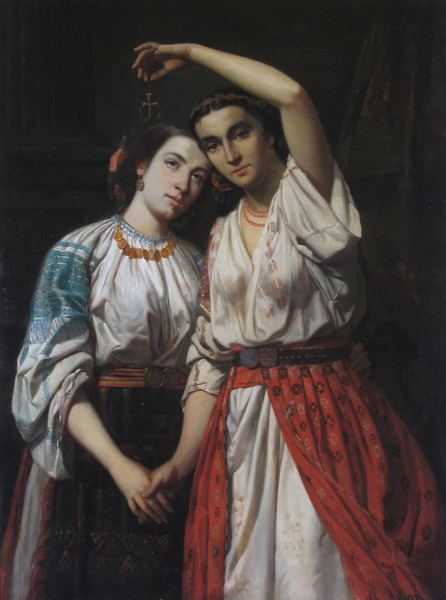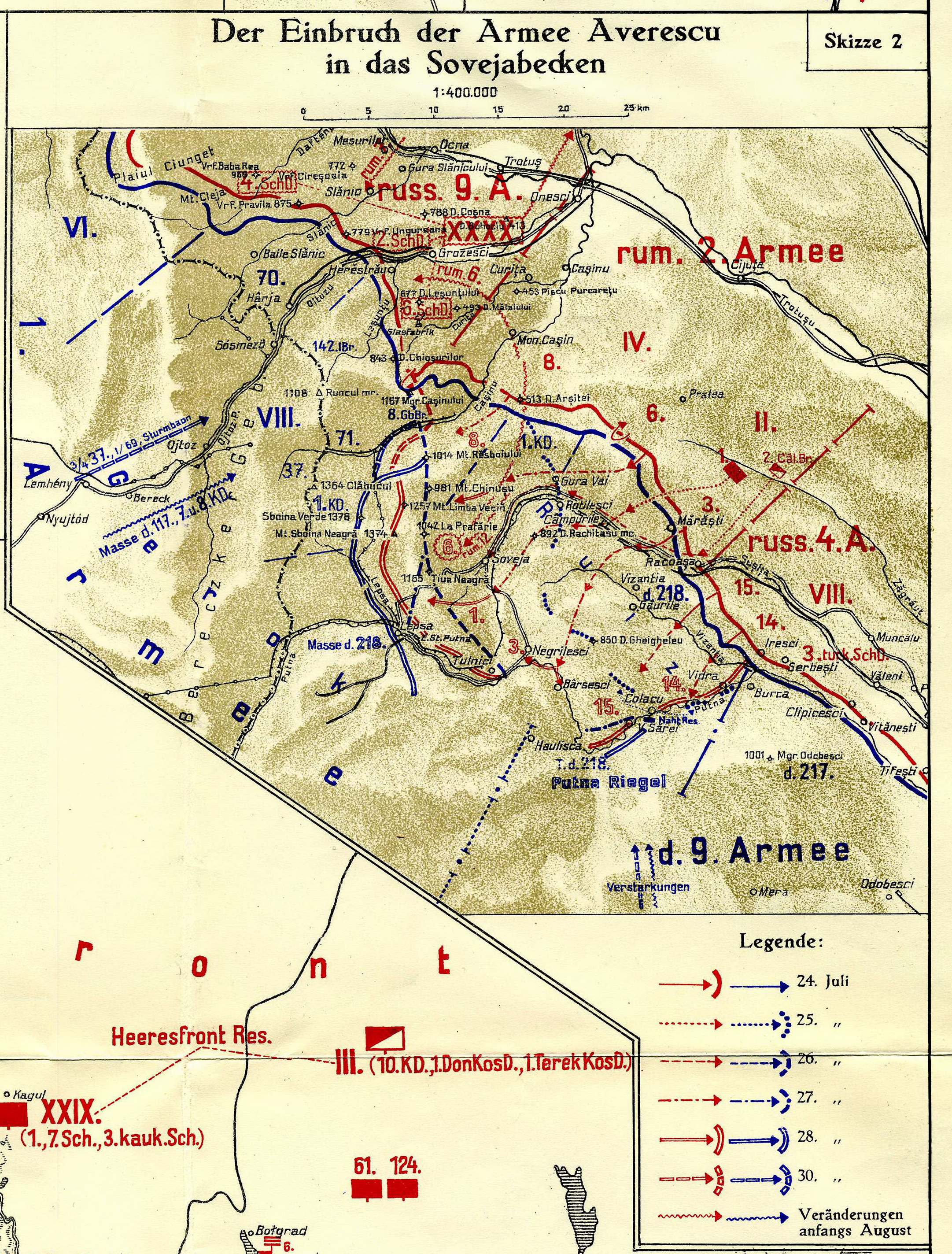|
Battle Of Mărășești
The Battle of Mărășești (6 August 1917 – 3 September 1917) was the last major battle between the German Empire and the Kingdom of Romania on the Romanian front during World War I. Romania was mostly occupied by the Central Powers, but the Battle of Mărășești kept the northern region of the country free from occupation. Background Mărășești, just like Mărăști, is part of the strategically important area of the Focșani Gate. Control of this area eases attacks into several Romanian regions. On 22 July 1917, the Romanians launched a joint offensive with Russia against the Austro-Hungarian 1st Army, around Mărăști and the lower part of the Siret river, which resulted in the Battle of Mărăști. Although there was some initial success, a counter-offensive by the Central Powers in Galicia stopped the Romanian-Russian offensive. Battle The Central Powers planned a dual pincer movement attack: an offensive towards Adjud and an offensive towards Oituz. Th ... [...More Info...] [...Related Items...] OR: [Wikipedia] [Google] [Baidu] |
Romanian Campaign (1917)
The 1917 Romanian Campaign consisted in three battles between late July and early September 1917, fought between Germany and Austria-Hungary on one side versus Romania and Russia on the other. Romania emerged from this campaign with a slight net territorial gain and won its most important battle during the First World War. Background Although largely overrun in the winter of 1916, Romania had managed to remain in the war, holding a territorial rump in Moldavia with assistance from Russian forces. The French military mission in Romania helped rebuild the Romanian Army, as Russia's was disintegrating. The reorganization of the Romanian Army had been completed by June 1917. The 1,500-strong French military mission, headed by General Henri Berthelot, included 300 officers who provided expert instruction in the use of new weapons and tactics, particularly the conduct of a war of position. The Romanian Army at the end of the reorganization stood at 460,000 strong (not including irregu ... [...More Info...] [...Related Items...] OR: [Wikipedia] [Google] [Baidu] |
Kingdom Of Romania
The Kingdom of Romania ( ro, Regatul României) was a constitutional monarchy that existed in Romania from 13 March ( O.S.) / 25 March 1881 with the crowning of prince Karl of Hohenzollern-Sigmaringen as King Carol I (thus beginning the Romanian royal family), until 1947 with the abdication of King Michael I of Romania and the Romanian parliament's proclamation of the Romanian People's Republic. From 1859 to 1877, Romania evolved from a personal union of two vassal principalities (Moldavia and Wallachia) under a single prince to an autonomous principality with a Hohenzollern monarchy. The country gained its independence from the Ottoman Empire during the 1877–1878 Russo-Turkish War (known locally as the Romanian War of Independence), when it also received Northern Dobruja in exchange for the southern part of Bessarabia. The kingdom's territory during the reign of King Carol I, between 13 ( O.S.) / 25 March 1881 and 27 September ( O.S.) / 10 October 1914 is sometimes refe ... [...More Info...] [...Related Items...] OR: [Wikipedia] [Google] [Baidu] |
Panciu
Panciu () is a town in Vrancea County, Romania. It lies on the river Șușița, in the southern part of Western Moldavia, northwest of Focșani. It has a population of approximately 7,600. It administers five villages: Crucea de Jos, Crucea de Sus, Dumbrava, Neicu and Satu Nou. The town is located in the east-central part of the county, on the banks of the Șușița River. The region is famous for its white wines but also for its sparkling wine Sparkling wine is a wine with significant levels of carbon dioxide in it, making it fizzy. While the phrase commonly refers to champagne, European Union countries legally reserve that term for products exclusively produced in the Champagne regi ...s (white, red and rosé). Writer Ioan Slavici died in Panciu in 1926, and was buried at the hermitage within . Natives * Stelian Isac * Dan Nica References External links Panciu Town Hall Towns in Romania Populated places in Vrancea County Localities in Western Moldavia ... [...More Info...] [...Related Items...] OR: [Wikipedia] [Google] [Baidu] |
Focșani
Focșani (; yi, פֿאָקשאַן, Fokshan) is the capital city of Vrancea County in Romania on the banks the river Milcov, in the historical region of Moldavia. It has a population () of 79,315. Geography Focșani lies at the foot of the Curvature Carpathians, at a point of convergence for tectonic geologic faults, which raises the risk of earthquakes in the vicinity. Though Vrancea County is one of the most popular wine-producing regions in Romania, Odobești being just to the northwest, in Romania, Focșani itself is not considered a wine-producing center. The wine sold as ''Weisse von Fokshan'' in Germany and some other European countries is generally a ''Fetească Albă de Odobești'' wine, and practically a second-rated wine which does not comply to the European Union rules of naming the regions of origin of wines. The vicinity is rich in minerals such as iron, copper, coal, and petroleum. The city administers two villages, Mândrești-Moldova and Mândrești-Munteni. ... [...More Info...] [...Related Items...] OR: [Wikipedia] [Google] [Baidu] |
Oituz (river)
The Oituz ( hu, Ojtoz) is a right tributary of the river Trotuș in Romania. It discharges into the Trotuș in Onești. e-calauza.ro The following towns and villages are situated along the river Oituz, from source to mouth: Oituz (CV), Poiana Sărată, Oituz (BC), Bogdănești and Onești
Onești (; hu, Ónfalva) is a munic ...
[...More Info...] [...Related Items...] OR: [Wikipedia] [Google] [Baidu] |
Adjud
Adjud (; hu, Egyedhalma) is a city in Vrancea County, Western Moldavia, Romania. It has a population of 14,670 inhabitants (2011). It lies at a railway junction which has a classification yard and a passenger station. Adjud, situated north of the point where the river Trotuș enters the Siret, used to be a marketplace. The city administers three villages: Adjudu Vechi, Burcioaia and Șișcani. Geography Adjud is situated on a plain and is surrounded by hills up to a height of 400 meters at the foot of the southern Carpathians. The average altitude of the town is 100 m above sea level. The surrounding land is favorable for agriculture. Geological research findings show the city's subsoil having layers of gravel and sand Levantine and Quaternary, forming significant hydrological aquifers deposits fed by the Trotuș and Siret rivers and direct rainfalls. The climate is temperate with annual average temperature of 8- and an average rainfall of 500 mm / m a year. It is char ... [...More Info...] [...Related Items...] OR: [Wikipedia] [Google] [Baidu] |
Kingdom Of Galicia And Lodomeria
The Kingdom of Galicia and Lodomeria,, ; pl, Królestwo Galicji i Lodomerii, ; uk, Королівство Галичини та Володимирії, Korolivstvo Halychyny ta Volodymyrii; la, Rēgnum Galiciae et Lodomeriae also known as Austrian Galicia or colloquially Austrian Poland, was a constituent possession of the Habsburg monarchy in the historical region of Galicia in Eastern Europe. The crownland was established in 1772. The lands were annexed from the Polish-Lithuanian Commonwealth as part of the First Partition of Poland. In 1804 it became a crownland of the newly proclaimed Austrian Empire. From 1867 it was a crownland within the Cisleithanian or Austrian half of the dual monarchy of Austria-Hungary. It maintained a degree of provincial autonomy. Its status remained unchanged until the dissolution of the monarchy in 1918. The domain was initially carved in 1772 from the south-western part of the Polish–Lithuanian Commonwealth. During the following ... [...More Info...] [...Related Items...] OR: [Wikipedia] [Google] [Baidu] |
Battle Of Mărăști
The Battle of Mărăști ( ro, Bătălia de la Mărăști) was one of the main battles to take place on Romanian soil in World War I. It was fought between 22 July and 1 August 1917, and was an offensive operation of the Romanian and Russian armies intended to encircle and destroy the German 9th Army. The operation was planned to occur in tandem with the Nămoloasa offensive; however, this operation was abandoned before it began. Background Mărăști, just like Mărășești, is part of the strategically important Focșani Gate, the control of which eases attacks into several Romanian regions. The opposing forces At the beginning of July, based on the campaign plan drawn up in May by the High Command, final instructions were given to the 1st and 2nd Romanian Armies. The 1st Army was to carry out the principal attack around Nămoloasa and then, on terrain prepared by the latter, the 2nd Army, commanded by General Alexandru Averescu, was to carry out a second-order attack towar ... [...More Info...] [...Related Items...] OR: [Wikipedia] [Google] [Baidu] |
Siret River
The Siret or Sireth ( uk, Сірет or Серет, ro, Siret , hu, Szeret, russian: Сирет) is a river that rises from the Carpathians in the Northern Bukovina region of Ukraine, and flows southward into Romania before it joins the Danube. It is long,Planul de management al spațiului hidrografic Siret Administrația Națională Apele Române of which in Romania, and its basin area is , of which in Romania. Its average discharge is . [...More Info...] [...Related Items...] OR: [Wikipedia] [Google] [Baidu] |
Austria-Hungary
Austria-Hungary, often referred to as the Austro-Hungarian Empire,, the Dual Monarchy, or Austria, was a constitutional monarchy and great power in Central Europe between 1867 and 1918. It was formed with the Austro-Hungarian Compromise of 1867 in the aftermath of the Austro-Prussian War and was dissolved shortly after its defeat in the First World War. Austria-Hungary was ruled by the House of Habsburg and constituted the last phase in the constitutional evolution of the Habsburg monarchy. It was a multinational state and one of Europe's major powers at the time. Austria-Hungary was geographically the second-largest country in Europe after the Russian Empire, at and the third-most populous (after Russia and the German Empire). The Empire built up the fourth-largest machine building industry in the world, after the United States, Germany and the United Kingdom. Austria-Hungary also became the world's third-largest manufacturer and exporter of electric home appliances, e ... [...More Info...] [...Related Items...] OR: [Wikipedia] [Google] [Baidu] |
Russian Republic
The Russian Republic,. referred to as the Russian Democratic Federal Republic. in the 1918 Constitution, was a short-lived state which controlled, ''de jure'', the territory of the former Russian Empire after its proclamation by the Russian Provisional Government on 1 September (14 September, ) 1917 in a decree signed by Alexander Kerensky as Minister-Chairman and Alexander Zarudny as Minister of Justice.The Russian Republic Proclaimed at prlib.ru, accessed 12 June 2017 The of the Russian Republic was dissolved after the Bolsheviks seized power by ... [...More Info...] [...Related Items...] OR: [Wikipedia] [Google] [Baidu] |


.jpg)


